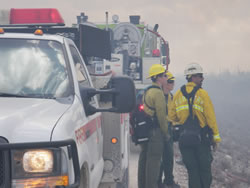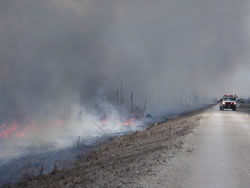
National Fire Plan Success Story
Park Provides Mutual Aid and an Ecological Message
Everglades National Park, Florida
National Fire Plan - Firefighting
2011

Everglades firefighters Colleen Holland and Erika Hoopes (left) consult with Florida Forest Service division supervisor Gary Lewis. NPS photos by Robert Trincado.

Everglades Engine 605 monitoring backfiring operations with Florida Forest Service and Miami-Dade Fire Rescue trucks behind them.
On Friday, March 4, 2011, Everglades National Park wildland fire engines responded to a mutual aid request from the Florida Forest Service to assist in the suppression of a wildfire burning near Highway 41, Tamiami Trail. The fire caused several intermittent traffic closures on the highway during the day as it threatened to spread west into flammable dead and dry melaleuca trees toward the Miccosukee Reservation.
Everglades’s firefighters conducted backfiring operations, taking away fuel ahead of the fire to prevent it from spreading. By the end of the day, they had helped the Florida Forest Service and Miami-Dade County firefighters achieve 95 percent containment at 400 acres. Miami-Dade County fire officials considered the potentially catastrophic fire a harbinger of a difficult spring fire season. South Florida is in the midst of a severe seasonal drought with no reprieve in sight until mid-April, when the rains usually return.
Newspaper coverage in the Miami Herald included a positive message about the role of fire in the Everglades ecosystem, thanks to previous outreach conducted by the National Park Service. In December 2009, Everglades National Park hosted a media event at a prescribed burn in Shark Valley, one of the park’s most popular visitor destinations. Among the reporters who attended the December 2009 burn was the same newsman who would later cover the March 2011 wildfire, Curtis Morgan. In his story about the 2011 wildfire, Morgan pointed out that “regular doses of flame are essential to the health of many Florida ecosystems” and quoted Everglades Fire Management Officer Rick Anderson’s characterization of the Everglades as “built to burn.”
The incident demonstrated how pre-season communication strategies, such as media escorts on prescribed burns, can improve media coverage of wildfire response. The incident was a success story not only for Everglades firefighting operations, but also for public education about the fire ecology of the Everglades.
Contact: Rick Anderson, Fire Management Officer, (305) 242-7853